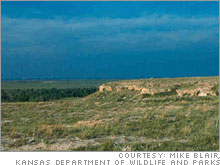 |
| Cimarron National Grassland -- Kansas |
|
|
|
NEW YORK (CNN/Money) -
Iowa legislators are taking dead aim at one of the state's biggest problems: retaining young residents. A proposed tax break could put an extra $600, on average, in the pocket of every resident under 30 years old.
"We're a rapidly aging population," says Jeff Lamberti, an Iowa state senator who helped introduce the bill. "We're approaching a time when every dollar of new revenue we get will be spent on just one thing, Medicaid."
Nearly twice as many counties in the state have lost residents in the last 70 years than have gained. As in much of the Midwest, rural areas suffer most.
The story repeats itself throughout America's heartland, where stagnant or negative population growth has long been the norm.
Nearly every midwestern farm state is scrambling to respond, often by putting together packages of personal and business incentives.
North Dakota supports buffalo production and eco-tourism as ways to stimulate growth. The state facilitates loans to ranchers and its agricultural extension service offers technical assistance.
Some Kansas towns give away land. (See Free land in the heartland.)
The U.S. Congress has even entered the fray, considering a "New Homestead Act," which includes a long list of personal and business incentives designed to re-ignite growth in rural areas.
Stemming the tide
Desertion from small family farms constitutes the largest population movement in American history, according to Frank and Deborah Popper, a husband-and-wife team of land use experts and authors of the controversial academic paper, Buffalo Commons.
With mechanization, one man and a combine can replace teams of farm workers. This reduces not only the numbers of people living on the land, but it also affects the nearby towns that provided goods and services to those people.
Stores, schools, churches, theaters, and medical offices all have seen their customer bases shrink. Many close. Remaining farm residents often must travel great distances to buy groceries.
"If current trends continue, there will be little left in rural counties," says Chuck Hassebrook, executive director of the non-profit Center for Rural Affairs.
Will a tax break for the young help stem the tide in Iowa? Frank Popper is dubious.
"The underlying economic fundamentals determine whether these things work," he says.
Sen. Lamberti points out that the under-30 tax credit is just one part of a bigger economic incentive package being debated in the legislature. It includes tax credits for job creation, to build on other measures offering grants and loans to businesses.
Rebecca Ryan, a founder of the Wisconsin-based Next Generation Consulting, is skeptical about the tax break for twentysomethings.
"I call them 'Happy Meal' incentives," Ryan says. "Calculate them over 26 pay periods and that's what they amount to." Moreover, she argues, the incentives target the wrong age group.
"Everyone goes through a stage where they want to leave home," says Ryan. "Let the young people leave the community, but then hit them with incentives to return when they're ready to settle down."
In Nebraska, micro-loans have enabled a number of people to start successful small businesses, according to Hassebrook of the Center for Rural Affairs.
Some farmers are also prospering by meeting the demand for more natural foods.
"They're raising pork on small farms using environmentally responsible methods and commanding a premium price," says Hassebrook.
Frontier towns
"Ambitious youngsters are not going to let $600 influence their career choices," says former Kansas governor Mike Hayden.
Kansas does have a successful program designed to keep doctors in rural areas � the state forgives student loans from graduates of its medical program, a fixed amount for every year spent in a rural county. Similar programs could be applied to other young professionals.
"We face a severe shortage of dentists, for example," says Hayden. "It would work for veterinarians, too."
Another idea is to find alternative uses for played-out farmland, as in the Buffalo Commons concept.
The Poppers suggest that low population densities in large areas of the Great Plains already qualify them as frontier areas and they should be restored to native plants and wildlife. Then, through eco-tourism and niche-marketing of bison products, the local economies could stabilize.
Many rural residents view that as a kind of surrender.
"People have the mindset that we have to claim this land from Mother Nature," says Hayden. It's ingrained in them to fight back against any wilderness incursions.
To wrest crops from the harsh land, farmers have had to mine water for decades, and the water is drying up. "I went to a presentation that showed that three-quarters of the streams in the western part of the state no longer flow," says Hayden.
In the southwestern part of the state, an area settled in the 1880s, the sandy soil blew away during the 1930s dust bowl. "People just walked away from the land," says Hayden. The government started buying it up for $3 or $5 an acre and set about restoring it to native grass.
Twenty-five years later, they discovered natural gas and oil. Today, the government shares revenue from those resources with local towns and schools, rents grazing rights on most of the 108,000-acre tract, called Cimarron National Grassland, and keeps it open for hunting and fishing, and other recreation.
The area is now one of the few rural places in Kansas not losing population. "It demonstrates that these kinds of things can, and do, work," says Hayden.
Concepts such as Buffalo Commons may signal a rebirth, but one that encompasses a more harmonious integration of man and nature.
Hayden thinks cost-effective plans like these could help stop the bleeding by providing a stable economic base and by improving the quality of life, making it more attractive for long-time residents and newcomers as well.

|